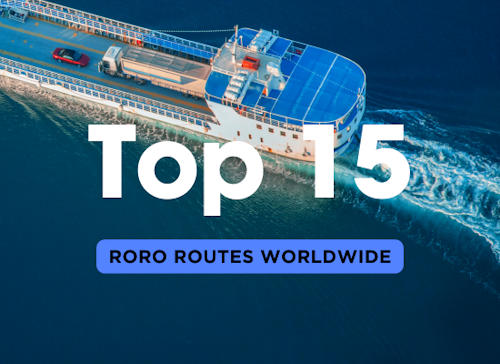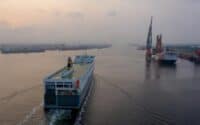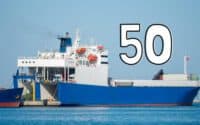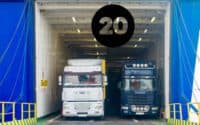The Top 15 RoRo Routes Worldwide

RoRo (Roll-on/Roll-off) shipping routes are the arteries of global trade, enabling the seamless transportation of wheeled cargo such as cars, trucks, and machinery across the world's oceans. These specialized ships are essential for the automotive industry, heavy machinery manufacturers, and even military logistics, providing a reliable and efficient means of moving goods. With the demand for RoRo services steadily increasing, certain routes have emerged as key players in the global logistics network. Let's explore the top 15 RoRo routes worldwide.
1. Europe to West Africa Route
The Europe to West Africa RoRo route is one of the most crucial corridors for vehicle exports. This route is particularly significant for the export of used cars, trucks, and construction equipment from Europe to various West African nations.
- Key Ports: Antwerp (Belgium), Hamburg (Germany), Lagos (Nigeria), Tema (Ghana)
- Cargo: Primarily used cars, trucks, construction machinery
- Trade Importance: Supports the automotive markets in West Africa, which rely heavily on imported vehicles
- Challenges: Navigating political instability, port congestion, and customs regulations in West African ports
2. Japan to Southeast Asia Route
As a major hub for automotive manufacturing, Japan’s RoRo routes to Southeast Asia are vital for the export of new vehicles. This route is highly organized, with a focus on delivering high volumes of cars to emerging markets in the region.
- Key Ports: Yokohama (Japan), Laem Chabang (Thailand), Manila (Philippines), Jakarta (Indonesia)
- Cargo: New cars, motorcycles, heavy machinery
- Trade Importance: Facilitates the distribution of Japanese vehicles across rapidly growing markets in Southeast Asia
- Challenges: Seasonal monsoons, port infrastructure limitations, and varying import regulations
3. North America to Europe Route
The RoRo route between North America and Europe is a critical link for the automotive industry, especially for high-end vehicles and heavy machinery. This route supports transatlantic trade, connecting major manufacturing hubs in the U.S. and Canada with consumer markets in Europe.
- Key Ports: Baltimore (USA), Bremerhaven (Germany), Southampton (UK), Zeebrugge (Belgium)
- Cargo: Luxury cars, trucks, agricultural and construction equipment
- Trade Importance: Crucial for luxury vehicle brands and industrial equipment manufacturers targeting European markets
- Challenges: Harsh North Atlantic weather conditions, stringent environmental regulations, and high operational costs
4. South Korea to the Middle East Route
South Korea, home to major automotive giants, utilizes this route to export vehicles and heavy equipment to the Middle East. This route is significant for both new and used vehicles, catering to markets with high demand for automotive imports.
- Key Ports: Busan (South Korea), Jebel Ali (UAE), Dammam (Saudi Arabia), Sohar (Oman)
- Cargo: New and used cars, heavy machinery, construction equipment
- Trade Importance: Supports the growing automotive markets in the Middle East, particularly in the Gulf Cooperation Council (GCC) countries
- Challenges: Navigating the Strait of Hormuz, regional political tensions, and extreme weather conditions
5. China to Africa Route
The China to Africa RoRo route has become increasingly important as China strengthens its trade relationships with various African nations. This route primarily supports the export of construction machinery, commercial vehicles, and new cars, contributing to infrastructure development across Africa.
- Key Ports: Shanghai (China), Dar es Salaam (Tanzania), Mombasa (Kenya), Lagos (Nigeria)
- Cargo: Construction machinery, commercial vehicles, new and used cars
- Trade Importance: Essential for infrastructure projects in Africa, with Chinese equipment and vehicles playing a crucial role in development efforts
- Challenges: Long transit times, varying port infrastructure quality, and navigating piracy-prone areas
6. Australia to New Zealand Route
The Australia to New Zealand RoRo route is a key link for vehicle trade between these neighboring nations. This short but vital route ensures the smooth flow of cars, agricultural machinery, and industrial equipment across the Tasman Sea.
- Key Ports: Melbourne (Australia), Brisbane (Australia), Auckland (New Zealand), Wellington (New Zealand)
- Cargo: Cars, agricultural machinery, industrial equipment
- Trade Importance: Critical for maintaining the vehicle and machinery supply chain between Australia and New Zealand
- Challenges: Navigating the Tasman Sea’s unpredictable weather, strict biosecurity regulations, and managing the high volume of cargo in a short distance
7. Northern Europe to the Mediterranean Route
This RoRo route connects the industrial heartlands of Northern Europe with key Mediterranean ports, facilitating the movement of vehicles, machinery, and other wheeled cargo. The route is crucial for trade between European Union member states and their southern neighbors.
- Key Ports: Rotterdam (Netherlands), Hamburg (Germany), Genoa (Italy), Barcelona (Spain)
- Cargo: New and used cars, trucks, industrial machinery
- Trade Importance: Supports intra-European trade and exports to North Africa, with a focus on automotive and industrial sectors
- Challenges: Navigating the busy Strait of Gibraltar, dealing with diverse regulatory environments, and managing port congestion
8. Brazil to Argentina Route
The Brazil to Argentina RoRo route is a vital connection for the South American automotive market, with both countries being major producers and consumers of vehicles. This route supports the intra-continental trade of cars, agricultural equipment, and construction machinery.
- Key Ports: Santos (Brazil), Rio Grande (Brazil), Buenos Aires (Argentina), Rosario (Argentina)
- Cargo: Cars, agricultural equipment, construction machinery
- Trade Importance: Essential for maintaining the flow of goods within South America, particularly in the growing automotive and agricultural sectors
- Challenges: Navigating the complex River Plate estuary, dealing with regional economic fluctuations, and managing customs procedures
9. East Coast USA to Central America Route
This RoRo route is significant for the export of vehicles, construction equipment, and agricultural machinery from the East Coast of the United States to Central America. It plays a crucial role in supporting the development of infrastructure and agriculture in Central American countries.
- Key Ports: Jacksonville (USA), Port Everglades (USA), Puerto Cortés (Honduras), Colón (Panama)
- Cargo: Vehicles, construction equipment, agricultural machinery
- Trade Importance: Supports the economic development of Central America by providing essential machinery and vehicles for infrastructure projects
- Challenges: Navigating the Caribbean Sea’s hurricane season, dealing with varying port infrastructure, and managing customs regulations in multiple countries
10. Northern Europe to North America Route
The Northern Europe to North America RoRo route is one of the busiest transatlantic corridors, connecting major automotive and industrial hubs across the Atlantic. This route is vital for the export and import of vehicles, agricultural machinery, and other heavy equipment between these two regions.
- Key Ports: Bremerhaven (Germany), Antwerp (Belgium), Southampton (UK), Baltimore (USA), New York (USA)
- Cargo: Luxury cars, trucks, agricultural machinery, industrial equipment
- Trade Importance: Crucial for the automotive and industrial trade between Europe and North America, particularly for high-value goods
- Challenges: Navigating the North Atlantic's harsh weather conditions, dealing with stringent customs and environmental regulations, and managing high cargo volumes
11. India to East Africa Route
The India to East Africa RoRo route has gained importance as trade between the Indian subcontinent and East Africa continues to grow. This route supports the export of vehicles, motorcycles, and industrial machinery to developing markets in East Africa.
- Key Ports: Mumbai (India), Chennai (India), Mombasa (Kenya), Dar es Salaam (Tanzania)
- Cargo: Cars, motorcycles, industrial machinery
- Trade Importance: Supports the rapid development of automotive and industrial sectors in East Africa, with India playing a key role as a supplier
- Challenges: Navigating piracy-prone waters, dealing with varying port infrastructure quality, and managing customs procedures in multiple countries
12. Turkey to Northern Europe Route
The Turkey to Northern Europe RoRo route is essential for the automotive industry, particularly for the export of vehicles manufactured in Turkey to major markets in Northern Europe. This route is heavily utilized by European car manufacturers that have production facilities in Turkey.
- Key Ports: Istanbul (Turkey), Izmir (Turkey), Rotterdam (Netherlands), Hamburg (Germany)
- Cargo: New cars, trucks, industrial equipment
- Trade Importance: Vital for connecting Turkey’s automotive manufacturing industry with Northern European markets, supporting both exports and intra-European trade
- Challenges: Navigating the busy Bosphorus Strait, dealing with regional geopolitical tensions, and managing high cargo volumes and tight schedules
13. South America to West Africa Route
The South America to West Africa RoRo route is a growing corridor, facilitating the export of vehicles, agricultural machinery, and construction equipment. This route is particularly important as trade ties between these two regions continue to strengthen.
- Key Ports: Santos (Brazil), Montevideo (Uruguay), Lagos (Nigeria), Tema (Ghana)
- Cargo: Used cars, agricultural machinery, construction equipment
- Trade Importance: Supports infrastructure development in West Africa, with South American exports playing a crucial role in these efforts
- Challenges: Long transit times across the South Atlantic, varying port infrastructure, and navigating the complex customs regulations in West African countries
14. Australia to Southeast Asia Route
This route is vital for the export of vehicles, machinery, and other wheeled cargo from Australia to Southeast Asia. It connects Australia’s industrial output with rapidly growing markets in Southeast Asia, particularly in Indonesia, Malaysia, and Thailand.
- Key Ports: Melbourne (Australia), Brisbane (Australia), Jakarta (Indonesia), Port Klang (Malaysia), Laem Chabang (Thailand)
- Cargo: Cars, agricultural and mining machinery, industrial equipment
- Trade Importance: Facilitates trade between Australia and Southeast Asia, supporting the region's industrial and agricultural sectors
- Challenges: Navigating the busy and congested waters of Southeast Asia, dealing with seasonal monsoons, and managing diverse regulatory environments
15. Scandinavia to the Baltic States Route
The Scandinavia to Baltic States RoRo route is a key intra-European corridor, connecting the Nordic countries with the Baltic region. This route is essential for the export of vehicles, industrial machinery, and other goods, supporting trade within Europe.
- Key Ports: Gothenburg (Sweden), Oslo (Norway), Tallinn (Estonia), Riga (Latvia)
- Cargo: Cars, industrial machinery, trucks
- Trade Importance: Supports regional trade and economic integration within Northern Europe, with a focus on the automotive and industrial sectors
- Challenges: Navigating the icy waters of the Baltic Sea, managing seasonal weather disruptions, and dealing with strict environmental regulations
| ShipUniverse: Top 15 RoRo Routes / Distance & Fuel Burn | |||
|---|---|---|---|
| Route | Distance (Nautical Miles) | Average Fuel Burn (Metric Tons) | Key Cargo |
| Europe to West Africa | 3,500 NM | 700 MT | Used cars, trucks, construction machinery |
| Japan to Southeast Asia | 2,000 NM | 400 MT | New cars, motorcycles, heavy machinery |
| North America to Europe | 4,000 NM | 800 MT | Luxury cars, trucks, industrial equipment |
| South Korea to the Middle East | 6,000 NM | 1,200 MT | New and used cars, heavy machinery |
| China to Africa | 7,500 NM | 1,500 MT | Construction machinery, commercial vehicles |
| Australia to New Zealand | 1,200 NM | 240 MT | Cars, agricultural machinery, industrial equipment |
| Northern Europe to the Mediterranean | 2,500 NM | 500 MT | New and used cars, trucks, industrial machinery |
| Brazil to Argentina | 1,000 NM | 200 MT | Cars, agricultural equipment, construction machinery |
| East Coast USA to Central America | 1,500 NM | 300 MT | Vehicles, construction equipment, agricultural machinery |
| Northern Europe to North America | 4,000 NM | 800 MT | Luxury cars, trucks, agricultural machinery |
| India to East Africa | 3,800 NM | 760 MT | Cars, motorcycles, industrial machinery |
| Turkey to Northern Europe | 2,200 NM | 440 MT | New cars, trucks, industrial equipment |
| South America to West Africa | 4,000 NM | 800 MT | Used cars, agricultural machinery, construction equipment |
| Australia to Southeast Asia | 3,000 NM | 600 MT | Cars, agricultural and mining machinery, industrial equipment |
| Scandinavia to the Baltic States | 800 NM | 160 MT | Cars, industrial machinery, trucks |
These 15 RoRo routes represent some of the most critical corridors in global maritime trade, each serving a unique purpose in connecting markets, facilitating trade, and supporting economic development. From the bustling ports of Europe to the emerging markets of Africa and Southeast Asia, RoRo shipping plays a pivotal role in the global logistics network. As demand for efficient and reliable transportation of wheeled cargo continues to grow, these routes will remain essential in ensuring the smooth flow of goods across the world's oceans. Whether it's the export of luxury cars, construction equipment, or industrial machinery, RoRo routes are the lifeblood of the global economy, linking manufacturers with consumers and driving growth in every corner of the world.

Do you have a Maritime Product or Service that may be of interest to Shipowners? Tell us about it here!
Do you have feedback or insights? Please reach out to editor @ shipuniverse.com



